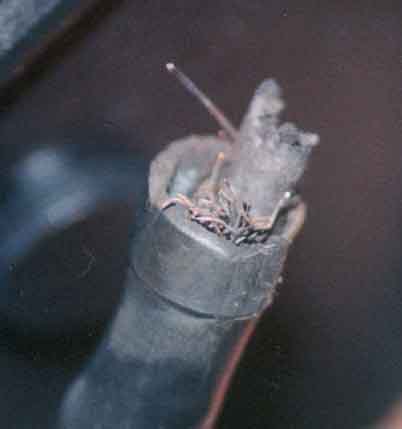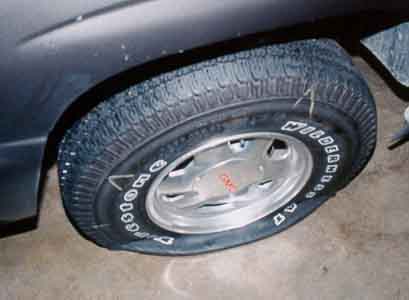LIGHTNING DAMAGE TO AUTOMOTIVE VEHICLES
by
Charles C. Roberts, Jr.
When the attraction between opposing charges in a thundercell and
the earth reaches a critical level, a lightning discharge occurs,
yielding a stroke of thousands of amperes. (See Claims, January
1998) Conductive apparatus in the path of the stroke can be
severely damaged, as evidenced by the following case study.

Figure 1
Figure 1 is a view (after partial disassembly by the dealer) of the
instrument panel of a late model vehicle that was parked outside a
home during a thunderstorm. After the thunderstorm, the owner
attempted to drive the vehicle with little success. The right front
tire was flat and the engine ran very poorly, operating in default
emergency mode. Dealer diagnostics indicated that several on-
board computers had failed.

Figure 2
Figure 2 is a view of the radio antenna tip showing melted metal,
which is characteristic of a high voltage discharge.

Figure 3
Figure 3 is a view of the antenna wire to the radio, which was
severed and badly burned. The antenna and wire were at the right
side of the vehicle. Figure 4 depicts the right front tire, which was
found to be flat. The tire was examined,

Figure 4
and three separate holes were found in the tire. Figures 5 and 6
show views of two of the three holes found in the tire. These holes
were not characteristic of road related damage. The tire had been
driven less than 1000 miles and was virtually new. Apparently, the
path of the current through the vehicle was from the antenna tip,
through the right side of the vehicle, through the right front tire, to
ground.

Figure 5

Figure 6
The damage to the tires shown in Figures 5 and 6 is characteristic
of electrical energy dissipation in the tire tread area. Several
microcomputers in the vehicle were also damaged. These devices
operate at low voltages (typically 5V) and very low currents, since
metalized paths on the chips are microscopic in nature. Stray, high
voltages, as indicated by the external damage to the vehicle, can
easily disable on-board microprocessors. Since there was no
evidence of contact with high voltage wiring on this vehicle, such
as arc burns from power lines, lightning is the likely cause of the
damage to the vehicle.
FOR TECHNICAL ARTICLES CONTACT CLAIMS MAGAZINE AND ASK
FOR A REPRINT OF A PAST TECHNICAL NOTEBOOK ARTICLE
CLAIMS MAGAZINE





